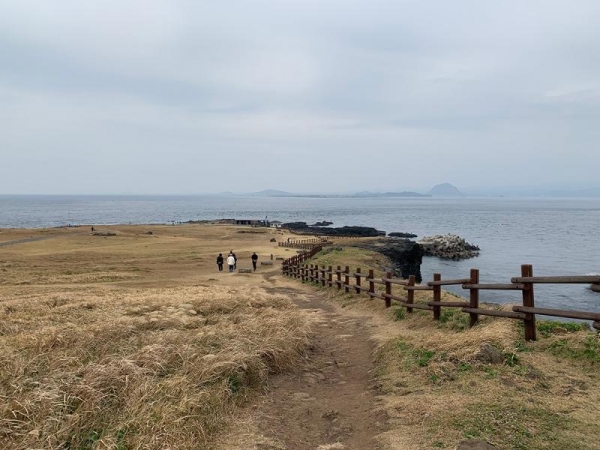Jeju Island is an hour's flight from Seoul and the biggest island in the country. Thanks to many spectacles created due to volcanic activity such as Hallasan Mountain, oreum (mini volcano), and columnar joints, the island is considered the nation's top travel spot. Before the COVID-19 pandemic hit, the number of visitors to the island including both domestic and foreign reached 1,528,613 in 2019.
Designated a UNESCO Biosphere Reserve in 2002, the island has three World Natural Heritage sites inscribed by the organization: Hallasan Mountain Natural Reserve, Seongsan Ilchulbong Tuff Cone, and Geomunoreum Volcanic Cone. In addition, the island features other spots that preserve history and nature.
Korea.net staff and foreign correspondents in Korea from Nov. 16-17 visited two places on the island with a harmonic coexistence of residents and nature.
Marado is the nation's southernmost island. It takes about 20 minutes by boat from Songaksan Port on Jeju to get to Marado and only 30 households reside on this island covering 0.3-sq. km with 168 species of wild plants that came across the sea from Jeju.
The Cultural Heritage Administration in 2000 designated Marado Island Natural Reserve. Walking along the promenade on the island's edge offers gorgeous views of beautiful coastal scenery with volcanic geological features and uniquely shaped rock cliffs formed by years of weathering.
Marado, the nation's southernmost island

Marado is the nation's southernmost island. It takes about 20 minutes by boat from Songaksan Port on Jeju to get to Marado and only 30 households reside on this island covering 0.3-sq. km with 168 species of wild plants that came across the sea from Jeju.
The Cultural Heritage Administration in 2000 designated Marado Island Natural Reserve. Walking along the promenade on the island's edge offers gorgeous views of beautiful coastal scenery with volcanic geological features and uniquely shaped rock cliffs formed by years of weathering.
Marado is said to have originally been uninhabited with dense primeval forests. People began settling there in 1883 during the 20th year of King Gojong's reign. The trees disappeared after settlers burned down the forests for clearing, which led to the island's present appearance of low grass.

The haenyeo, or professional female divers who gather seafood, are inseparable from Marado. Five of the island's 50 residents are such divers who go into the sea without oxygen tanks to collect seaweed and shellfish, including the island's specialties such as sea mustard and hijiki.
According to legend, haenyeo from Jeju's Moseulpo region entered Marado to get seafood but encountered high waves every time they tried to go home. Aegi Eopgae, a girl who gave babies piggyback rides who came on the island with the divers to take care of their babies while they worked, was left behind, as the haenyeo dreamed that they could not leave Marado unless the girl stayed there.
Aegi Eopgaedang Shrine is a memorial to the girl, who died after being left behind and longing for those who had fled the island, with nothing left but her skeleton. Marado residents and tourists make wishes or hold rituals at the shrine, a must-visit spot on the island.
Seonheulgot Dongbaekdongsan (Camellia Hill)

Gotjawal is a forest in Jeju created in a lava area that was formed nearly 10,000 years ago. The word got is from the Jeju dialect and means "grove," while jawal means a loose pile of rocks. Thus the term gotjawal refers to a forest made of trees and vines in a rocky area.
Seonheulgot Dongbaekdongsan (Camellia Hill) in the village of Seunheul 1-ri of Jocheon-eup Town in Jeju City is a leading gotjawal site. Fifty-nine of the 99 sq. m of the area is a natural reserve in which 16 species of endangered animals and plants live. The name "Dongbaekdongsan" is derived from the nearly 100,000 camellia trees there, but evergreens are also abundant due to the hill's constant temperature regardless of the season.
Gotjawal is a forest in Jeju created in a lava area that was formed nearly 10,000 years ago. The word got is from the Jeju dialect and means "grove," while jawal means a loose pile of rocks. Thus the term gotjawal refers to a forest made of trees and vines in a rocky area.
Seonheulgot Dongbaekdongsan (Camellia Hill) in the village of Seunheul 1-ri of Jocheon-eup Town in Jeju City is a leading gotjawal site. Fifty-nine of the 99 sq. m of the area is a natural reserve in which 16 species of endangered animals and plants live. The name "Dongbaekdongsan" is derived from the nearly 100,000 camellia trees there, but evergreens are also abundant due to the hill's constant temperature regardless of the season.

Meonmulkkak in Dongbaekdongsan is one of the forest's leading wetlands among hundreds formed in the area when raining. Meaning "water on the edge of faraway" in Jeju dialect, the wetland was often used by residents to water cows. In 2011, wetlands in the area including Meonmulkkak were designated Jeju's fourth wetlands conservation area by Ramsar Wetlands.
Seunheul 1-ri is an old village with over 650 years of history. Residents here lived with Dongbaekdongsan, drawing water from the wetlands, using trees for firewood and putting horses out to pasture, before the site was designated a Jeju cultural heritage and protected area in 1971.
In 2018, residents formed the social cooperative Seonheulgot to protect natural landscapes in the area and run a wetland center. Participating in resident-designed activities like an ecological field trip, food culture experience and environmental education also offers unusual fun to visitors.


